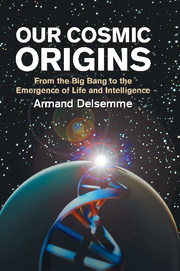Book contents
- Frontmatter
- Contents
- Foreword
- Preface
- Acknowledgments
- 1 Locating humans in the Universe
- 2 The race toward complexity
- 3 The stellar alchemy of metals
- 4 The formation of the planets
- 5 The emergence of life
- 6 The history of life
- 7 The awakening of intelligence
- 8 The other worlds
- 9 Perspectives
- APPENDIX A The standard model of the physics of elementary particles
- APPENDIX B Symmetry in physics
- APPENDIX C The strange role of time in relativity
- APPENDIX D The measurement of long time spans and the age of the Universe
- APPENDIX E The standard model of the Big Bang
- APPENDIX F The cause of the Big Bang and inflation
- APPENDIX G Chirality
- Glossary
- Bibliography
- Figure index
- Table index
- Name index
- Subject index
APPENDIX D - The measurement of long time spans and the age of the Universe
Published online by Cambridge University Press: 05 August 2012
- Frontmatter
- Contents
- Foreword
- Preface
- Acknowledgments
- 1 Locating humans in the Universe
- 2 The race toward complexity
- 3 The stellar alchemy of metals
- 4 The formation of the planets
- 5 The emergence of life
- 6 The history of life
- 7 The awakening of intelligence
- 8 The other worlds
- 9 Perspectives
- APPENDIX A The standard model of the physics of elementary particles
- APPENDIX B Symmetry in physics
- APPENDIX C The strange role of time in relativity
- APPENDIX D The measurement of long time spans and the age of the Universe
- APPENDIX E The standard model of the Big Bang
- APPENDIX F The cause of the Big Bang and inflation
- APPENDIX G Chirality
- Glossary
- Bibliography
- Figure index
- Table index
- Name index
- Subject index
Summary
To understand cosmic evolution, it was necessary first to evaluate the immense times involved. It began with geology. To find the age of a rock, one method came out on top: that of measuring the time elapsed from the moment when a radioactive element was confined in the rock. Uranium-238 (238U) suits this particularly well, because it decays into lead-206 (206Pb) with a half-life of 4.5 billion years. This half-life is the time needed for half of the radioactive substance to decay. After two half-lives, there is only ¼ left; after three half-lives, ⅛, etc. This is what is called an exponential decay.
The ratio of 238U to 206Pb present in a rock is a direct measure of the age of solidification of this rock. When a rock solidifies, the radioactive clock is reset to start at zero, because there is no 206Pb in the uranium oxide crystal just formed (lead remains in the liquid state in the original magma or lava). The rate of radioactive decay is extraordinarily constant, and nothing short of destroying the rock can influence it. This stems from the fact that radioactive reactions call for much higher energies than do chemical reactions.
The oldest terrestrial rocks are 3.8 billion years old. NASA astronauts have brought back lunar rocks; the oldest of them are 4.1 billion years old. Most of the carbonaceous chondrites (coming from the asteroid belt) are all of the same age: 4.6 billion years to within 0.1 billion years.
- Type
- Chapter
- Information
- Our Cosmic OriginsFrom the Big Bang to the Emergence of Life and Intelligence, pp. 285 - 288Publisher: Cambridge University PressPrint publication year: 1998

